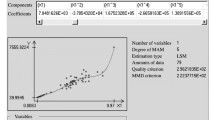Structurally parametric identification of the characteristics of the dispersion in the Friedmann–Robertson–Walker model and its approximations as models for cosmological distance scales are examined on the basis of the data on type SN Ia supernovae used to detect the “acceleration in the expansion of the universe.” It is shown that the deviations from the position characteristics of these models as a function of distance (the scale factor) are multiplicative. Estimates of the convolutions of the random and nonparametric unexcluded systematic components of the inadequacy errors of the Friedmann–Robertson–Walker model are obtained in the class of truncated distributions with zero curvature parameter and a Heckmann approximation with anisotropy and interpolation models taken into account.

Similar content being viewed by others
Notes
The scale factor for the cosmological distance scale should not be confused with the metric parameter of the space, which has the same name and a close physical significance.
Matt Visser is a professor of mathematics at Victoria and Wellington University (New Zealand).
Prof. Otto Hermann Leopold Heckmann was the head of the observatory and department of astronomy at the University of Hamburg (Germany) in 1942 and was elected president of the International Astronomical Union in 1967.
The limits of the possible deviations from the estimates are not indicated in Ref. 3.
References
A. A. Friedmann A. A., “Über die Krümmung des Raumes,” Z. für Physik, 10, 377–386 (1922).
A. G. Riess et al., “Observational evidence from supernovae for an accelerating universe and a cosmological constant,” Astron. J., 116, 1009–1038 (1998).
S. Perlmutter et al., “Measurements of Ω and Λ from 42 high-red shift supernovae,” Astrophys. J., 517, 565–586 (1999).
K. Lang, Astrophysical Formulas. Pt. 2 [Russian translation], Mir, Moscow (1978).
O. V. Verkhodanov, “Cosmological results from the ‘Planck’ space mission. Comparison with WMAP and BICEP-2 experimental data,” Usp. Fiz. Nauk, 186, No. 1, 3–46 (2016).
P. Ade et al., Planck Collaboration, “Planck 2015 results. XIII. Cosmological parameters,” Astron. & Astrophys., 594. A13 (2016).
A. G. Riess et al., “A 2.4% determination of the local value of the Hubble constant,” Preprint Astrophys. J., http://arXiv:1604.01424v3 [astro-ph.CO] 9 Jun 2016.
Planck Collaboration, “Planck intermediate results. XLVI. Reduction of large-scale systematic effects in HFI polarization maps and estimation of the reionization optical depth,” Astron. & Astrophys. Manusc., http://arXiv:1605.02985v2 [astro-ph.CO] 26 May 2016, acc Dec. 31, 2017.
M. Visser, “Jerk, snap, and the cosmological equation of state,” http://arXiv:gr-qc/0309109v4 31 Mar 2004.
O. Heckmann, Theorien der Kosmologie, Springer, Berlin (1942).
B. P. Schmidt, The Path to Measuring an Accelerating Universe: Nobel Lecture, Dec. 8, 2011.
D. Larson et al., “7 year WMAP observations: power spectra and WMAP-derived parameters,” Preprint WMAP, Jan. 26, 2010, http://lambda.gsfc.nasa.gov/product/map/dr4/pub_papers/sevenyear/powspectra/wmap_7yr_power_spectra.pdf, acc. May 28, 2010.
G. Hinshaw et al., “Nine-year Wilkinson Microwave Anisotropy Probe (WMAP) observations: Cosmological parameter results,” arXiv:1212.5226v3 [astro-ph.CO] June 4, 2013, acc. July 12, 2018.
P. A. R. Ade et al., Planck Collaboration, “Planck 2015 results: XIII. Cosmological parameters,” Astron. & Astrophys., 594, A13 (2016), arXiv:1502.01589v2 [astro-ph.CO] 6 Feb 2015, acc. Dec. 11, 2015.
W. L. Freedman, “Cosmology at a crossroads: Tension with the Hubble constant,” arxiv.org: 1706.02739 13 Jul 2017, acc. Dec. 3, 2017.
W. L. Freedman, B. F. Madore, B. K. Gibson, et al., “Final results from the Hubble Space Telescope Key Project to measure the Hubble constant,” Astrophys. J., 553, 47–72 (2001).
S. F. Levin, “The mathematical theory of measurement problems: Applications. Calibration in space and on earth – a metrological and scientifi c impasse?” Kontr.-Izmer. Prib. Sistemy, No. 2, 25–38 (2018).
S. F. Levin, “Cosmological distance scale. Part 7. A new special case with the Hubble constant and anisotropic models,” Izmer. Tekhn., No. 11, 15–21 (2018).
D. Yu. Tsvetkov, N. N. Pavlyuk, O. S. Bartunov, and Yu. P. Pskovskii, Supernovae Catalogue, Shternberg State Astronomical Institute, Moscow (2005), www.astronet.ru/db/sn/catalog.html.
S. F. Levin, Optimal Interpolation Filtration of Statistical Characteristics of Random Functions in a Deterministic Version of the Monte-Carlo Method and the Red Shift Law, NSK AN SSSR, Moscow (1980).
S. F. Levin, “Measurement problem of structural-parametric identification on supernovae type SN Ia for cosmological distances scale of red shift based,” Physical Interpretations of Relativity Theory: Proc. Int. Meeting, Bauman Moscow State Technical University, Moscow, June 29 – July 2, 2015, BMSTU, Moscow (2015), pp. 299–310.
S. F. Levin, “The measurement problem of identifying the error function,” Zakonodat. Prikl. Metrol., No. 4, 27–33 (2016).
S. F. Levin, “Statistical methods for the theory of measurement problems in cosmology,” Yad. Fiz. Inzhinir., 4, No. 9–10, 926–932 (2013).
I. Vuchkov, L. Boyadzhieva, and E. Solakov, Applied Linear Regression Analysis [Russian translation], Finansy i Statistika, Moscow (1987).
S. F. Levin and A. P. Blinov, “Scientifi c-methodological support for guaranteed solution of metrological problems by probabilistic-statistical methods,” Izmer. Tekhn., No. 12, 5–8 (1988).
S. F. Levin, “Metrological certifi cation and accompaniment of programs for statistical processing of data,” Izmer. Tekhn., No. 12, 16–18 (1988).
S. F. Levin, “Cosmological distance scale. Part 5. Metrological expert opinion based on type SN Ia supernovae,” Izmer. Tekhn., No. 8, 3–10 (2016).
M. V. Pruzhinskaya, Supernova Stars, Gamma-Bursts, and the Accelerated Expansion of the Universe: Auth. Abstr. Cand. Dissert. in Phys.-Math. Sci., Lomonosov Moscow State University, Moscow (2014).
S. F. Levin, “Cosmological distance scale. Part 6. Statistical anisotropy of red shift,” Izmer. Tekhn., No. 5, 3–6 (2017).
S. F. Levin, “Mathematical theory of measurement problems: Applications. Statistical monitoring procedures for high precision measurement,” Kontr.-Izmer. Prib. Sistemy, No. 3, 8–11 (2018).
Author information
Authors and Affiliations
Corresponding author
Additional information
Translated from Izmeritel’naya Tekhnika, No. 1, pp. 8–15, January, 2019.
Rights and permissions
About this article
Cite this article
Levin, S.F. Cosmological distance scale. Part 8. The scale factor. Meas Tech 62, 7–15 (2019). https://doi.org/10.1007/s11018-019-01578-1
Received:
Published:
Issue Date:
DOI: https://doi.org/10.1007/s11018-019-01578-1



